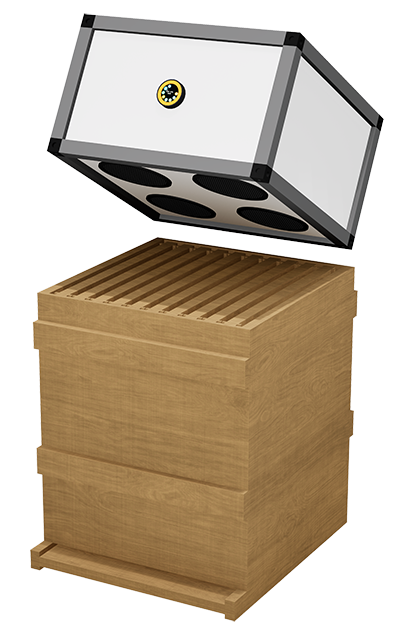
Save the bee,
save the future!

Představení
BeeHeater využívá zvýšených teplot v úlu k narušení reprodukce a případného usmrcení roztoče Varroa šetrnou metodou pro včelstvo bez použití toxických látek. Poskytuje účinné, jednoduché a ekologické řešení pro ochranu včel před Varroázou prostřednictvím kontrolovaného ohřevu, přispívající k udržitelnému a zdravému včelařství.Problém a řešení
Varroáza včel představuje celosvětově nejrozšířenější a nejzávažnější onemocnění včelího plodu a dospělých včel. Toto onemocnění způsobuje parazitický roztoč kleštík včelí, známý jako varroa destructor, vyskytující se na všech kontinentech, kromě Austrálie a Oceánie. V současné době se používá léčba akaricidy, které jsou též toxické pro včely. Další metody léčby je použití vonných olejů s nejistým výsledkem, kyseliny mravenčí a listové, což může způsobit kontaminaci medu. BeeHeater, inovativně využívá zvýšené teploty v úlu k potlačení roztoče Varroa. Při teplotě vyšší než 35,5°C se kleštík přestane množit, a při teplotě nad 40°C po dobu alespoň dvou hodin začne umírat.
Bee Safe
Crew
Martin Fox
Je autorem nápadu, nadšený vynálezce, konstruktér a designér se širokým spektrem odborností, zahrnující elektroniku, software mikročipů, a vývoj webových platforem. Úspěšně navrhuje elektronické systémy a konstrukce, přičemž prokázal schopnost spojit teoretické znalosti s praktickými dovednostmi. V současné době je Martin Fox vášnivě zaměřen na oblast umělé inteligence (AI), kde hledá kreativní způsoby, jak integrovat AI do procesů prodeje a řízení.
Marek Milfait
Je zkušeným programátorem a grafikem, stojící za vývojářskou firmou specializující se na zakázkový software a mobilní aplikace. Je vystudovaným strojařem, ale má i bohaté zkušenosti v oblasti mezinárodního obchodu, dovozu zahraničního zboží na český trh, s vedení PPC kampaní a implementací marketingu na sociálních sítích. V průběhu své kariéry Marek vystřídal několik povolání a vše co dělá se snažím dělat na 100%.
Děkujeme našim ženám za trpělivost, pomoc a podporu.
Liduška Milfaitová a Zuzana Thien Fox
Un-bee-lievable Confort
FAQ
Bude možnost použít zařízení mimo napájecí sítě 230/120V?
-
Ano, zařízení bude možné použít i mimo napájecí sítě 230/120V. K tomu nabízíme několik alternativních možností napájení:
- Benzínový generátor: Pro okamžité a spolehlivé napájení použít benzínový generátor. Tento generátor je schopen zajistit dostatečný výkon pro provoz zařízení.
- Powerbanka se solárním dobíjením: Momentálně pracujeme na spolupráci s firmou, která vyrábí powerbanky se solárním dobíjením. Toto řešení je ekologické a umožňuje dlouhodobý provoz zařízení i v odlehlých lokalitách bez přístupu k elektrické síti.
- Lithium baterie: Také zkoumáme možnosti napájení prostřednictvím nabíjecích lithium baterií. Toto řešení by mohlo poskytnout flexibilní a mobilní zdroj energie pro zařízení.
Mohu použít své nástavky?
- Zařízení je vyráběno na zakázku, proto bude vždy kompatibilní s vašimi nástavky. Velikost nástavků bude součástí objednávky, což zajišťuje, že všechny komponenty budou bez problémů spolupracovat. Tím je zaručena maximální flexibilita a spokojenost zákazníka.
Jak vás mohu podpořit?
-
V současné chvíli jsme ve startovací fázi, kdy vyrábíme jednotky kusů pro klinické testy, EMC testy, elektrické bezpečnostní testy a CE certifikaci. Můžete nás podpořit několika způsoby:
- Připojte se k naší komunitě na Facebooku: Staňte se součástí naší rostoucí komunity a sdílejte naše příspěvky, abychom mohli oslovit co nejvíce potenciálních zákazníků. Vaše zapojení a zpětná vazba jsou pro nás nesmírně cenné a pomáhají nám zdokonalovat naše produkty.
- Šíření myšlenky značky: Pomozte nám budovat naši značku tím, že budete šířit povědomí o našem produktu mezi svými přáteli, rodinou a kolegy. Každé sdílení a doporučení nám pomáhá přiblížit se k cíli vytvoření love brandu, který lidé nejen potřebují, ale také milují.
Funguje to?
- Ano, z biologického hlediska funguje prohřátí včelího úlu na teploty nad 40 °C, což způsobuje úhyn varroázy. Tato metoda je vědecky podložena, i když neznáme přesný počet varroázy před a po ošetření. V tomto ohledu se spoléháme na statistické srovnání s jinými roji, které byly ošetřeny konvenčními metodami pomocí akaricidů. Naše statistiky a dosavadní výsledky naznačují, že tato metoda je efektivní a nabízí alternativní způsob boje proti varroáze.
Kdy to použít?
- Použít na jaře a v létě před nebo během zakrmení včel, nebo v případě podezření na přítomnost varroázy. Nedoporučuje se však používat při teplotách pod 15 °C, aby se u včel nevyvolal velký teplotní šok.
Jaká je účinnost eradikace varroázy?
- Účinnost eradikace varroázy pomocí prohřívání včelího úlu na teploty nad 40 °C je vysoká. Tento teplotní režim způsobuje úhyn varroázy, což potvrzují naše dosavadní výsledky. Přestože nemáme přesné počty varroázy před a po ošetření, spoléháme na statistické metody. Nelze přesně spočítat počet varroázy v roji, protože včelí roj může obsahovat mezi 20 000 až 80 000 včel, a varroáza může být přítomna i v zavíčkovém plodu, což dále komplikuje přesné měření. Statistická analýza porovnává naše výsledky s roji ošetřenými konvenčními metodami pomocí akaricidů, a ukazuje, že tato metoda je velmi účinná a poskytuje spolehlivou alternativu v boji proti varroáze.
Hot bee-tches

CaveCoders s.r.o., Stříbro



